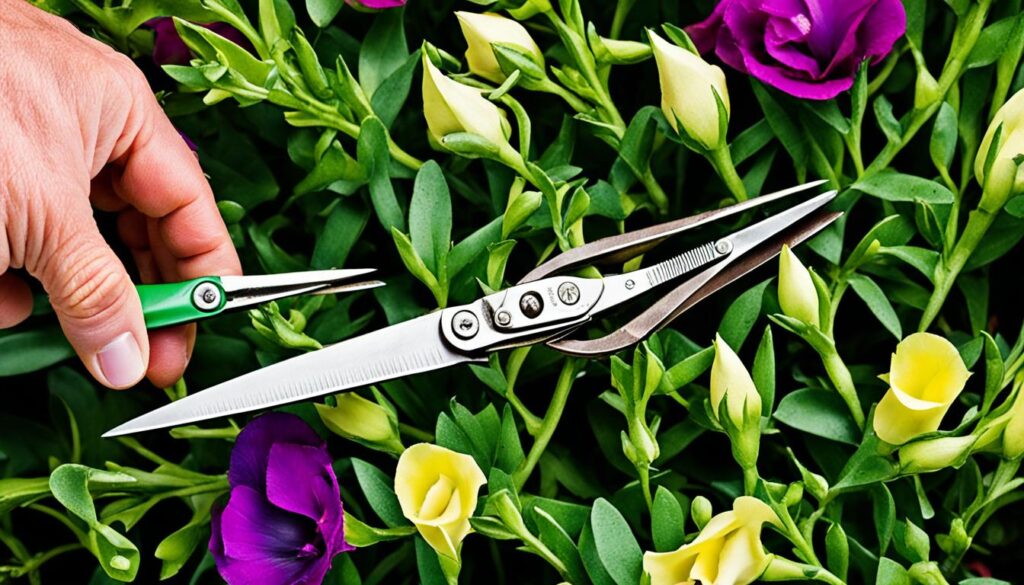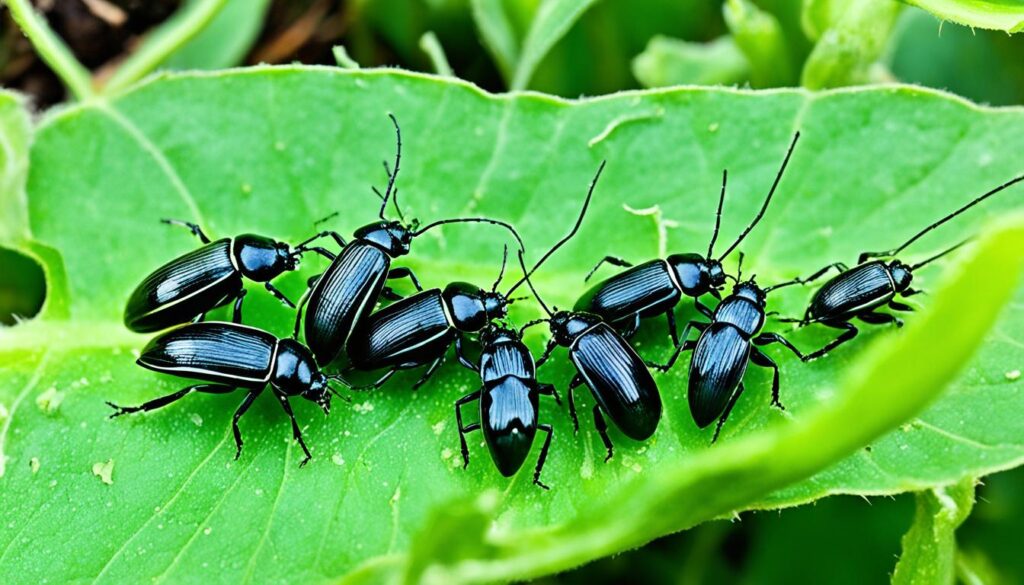
Ever thought about why lisianthus is loved by event florists and soon-to-be brides? This guide will show you the beauty of this cut flower. You’ll also learn how to grow it yourself, whether in your garden or greenhouse. This is for anyone interested, whether you’re familiar with floral arrangements or just starting out. We’ll share everything you need to know to grow these beautiful flowers.
Lisianthus (Eustoma spp.) are plants that need care each year. They are originally from places like northern Mexico to parts of the U.S. such as Colorado and Nebraska. They can reach between 1 and 3 feet high. The flowers look like bells with petals that spread out and they grow on straight stems. These flowers can be white, pink, purple, or cream, and sometimes yellow, apricot, rose, or red. The leaves are deep green and have a long, narrow shape. Lisianthus is very popular for weddings and other big events. It takes a lot of effort to grow them from seeds, so it’s easier to start with young plants from a store.
So, what’s the deal with lisianthus? Why is it a top choice for florists and gardeners everywhere? Let’s explore the magic that makes this flower so special. We’ll look into what sets it apart and why everyone loves it.
What is Lisianthus?
The flower known as lisianthus has the scientific name Eustoma russellianum. Before, it was called Eustoma grandiflorum. It comes from the Gentianaceae family. Besides lisianthus, it goes by names like prairie gentian, bluebell gentian, and Texas bluebells.
Botanical and Common Names
The botanical name for lisianthus is Eustoma russellianum (used to be called Eustoma grandiflorum). It is from the Gentianaceae plant family. Lisianthus is also known by other common names. These include prairie gentian, bluebell gentian, and Texas bluebells.
Plant Type and Characteristics
Lisianthus is either an herbaceous perennial or biennial, but it’s mainly grown as an annual. It has bell-shaped flowers with flaring lobes on stems that point up. These flowers usually reach 1 to 3 feet high and 6 to 12 inches across. The leaves are dark green, lance-shaped, and a bit fleshy.
Native Habitat and Hardiness Zones
Lisianthus comes from the grasslands and prairies along the 100th meridian. This area stretches from western Nebraska, through Texas, down to northern Mexico. It does well in dry winters and likes sandy, well-drained soils. Lisianthus can survive in US Hardiness Zones 8 to 10 and grow back every year. But in other regions, it’s more common to plant it as an annual.
Why Grow Lisianthus?
Lisianthus is loved for its stunning rose-like blooms. They come in many colors – white, pink, purple, and more. These flowers are perfect for gardens or cut flower arrangements, adding beauty to any space.
Rose-Like Blooms in Stunning Colors
The flowers of lisianthus look like roses but with a wider color range. They attract both gardeners and florists with their beauty. Lisianthus fits well with many color schemes and designs because of its varied colors.
Long-Lasting Cut Flowers
Lisianthus is famous for lasting a long time once cut. With the right care, they can stay fresh for 10 to 14 days. This makes them perfect for weddings, centerpieces, and other decorations.
Low-Maintenance and Drought-Tolerant
Lisianthus is easier to care for than roses. It is drought-tolerant and doesn’t have many problems with pests or diseases. This makes it a good choice for people in hot, dry places.
Starting Lisianthus from Seed
Lisianthus seeds are small and are usually made into pellets for easy handling. To plant them, place the seeds on top of a damp seed starting mix. Keep this mix at a temperature between 70°F and 75°F. Germination takes 5-6 months. After they sprout, lower the temperature to 50°F – 65°F to keep them growing.
Seed Preparation and Germination
Seed preparation and seed germination can be a challenge for lisianthus. But, with the correct steps, you can start these beautiful flowers from seed. Begin by placing the tiny seeds on a moist germination mix. Keep the temperature at 70°F to 75°F until they grow. This could take around 6 months.
Caring for Seedlings
When the seedlings appear, giving them the right conditions is key. Start by stopping any heat from below and keep the temperature at 50°F to 65°F. Be sure the soil they’re in is always moist, but not soaked. Also, they need 16 hours of light daily from grow lights. Each week, feed them with a weak, all-purpose plant food. As they get bigger, transplant them to larger containers. Before putting them in the garden, harden them off first.
Lisianthus Planting and Care
Lisianthus plants love the sunshine. They need 6 to 8 hours of direct sunlight every day. Make sure they are in well-draining soil. This soil should be rich and have a pH level between 6.5 and 7.0. Adding compost helps the soil drain better and be more fertile. Using raised beds or large containers with good potting mix is great for these flowers.
Site Selection and Soil Preparation
Choose a sunny spot for your lisianthus. This is key for site selection. It helps them grow well. To get the soil ready, add compost and mix it in. This creates a perfect place for your plants to thrive.
Spacing and Support
Plant lisianthus 4 to 9 inches apart, depending on the type. Taller ones might need a stake or cage to help them stand. If you plant them close together, they can lean on each other for support. This might save you from extra staking work.
Watering and Fertilizing
Keep lisianthus soil moist but not soggy. They generally need about 1 inch of water weekly. Adjust as needed to keep the soil evenly moist. Also, feed your lisianthus with a fertilizer that has a lot of phosphorus. This helps them grow strong and bloom a lot.
Lisianthus Varieties and Colors
Lisianthus comes in many varieties with each showcasing its own special color and size. They usually blossom during the summer. You can find them in shades like white, blue, purple, pink, and more. Among the known lisianthus varieties are ‘Balboa’, ‘Flamenco’, ‘Maurine’, ‘Sapphire Pink Rim’, and ‘Echo Blue’.
Each variety displays a unique flower color and shape, making them perfect for any garden or bouquet. Lisianthus is loved for its range of options. You might like the pure look of white flowers or the daring dark purple ones. There’s truly a lisianthus for every taste.
| Variety | Flower Color | Size |
|---|---|---|
| Balboa | Blue | Abundant Blooms |
| Flamenco | Pink, White, Yellow | Heat-Tolerant Singles |
| Maurine | Purple | Compact Habit |
| Sapphire Pink Rim | Pink with Purple Edge | Bicolor Blooms |
| Echo Blue | Dark Blue | Up to 34 Inches Tall |
Pruning and Deadheading
Proper pruning and deadheading can make your lisianthus bloom again in fall. After its first flowers, trim the plants down to just above the leaves. This helps the plant focus on growing new flowers.
To keep your lisianthus happy, give it plenty of water and the right fertilizer. With care, your lisianthus will blossom beautifully again in mid-September.

Lisianthus as Perennials and Propagation
In places with mild winters (USDA Zones 8-10), lisianthus can grow year-round. Take care of them by cutting them back to the ground when it gets cold. Then, cover them with a thin layer of mulch. When spring comes, these plants will grow back. To make new plants, you can split the root ball. Use a sharp tool to cut it into smaller parts. Be sure each part has some leaves and buds.
Overwintering and Dividing Plants
Another way to grow lisianthus is from cuttings. In the spring, cut a 4-6 inch piece off a plant. Take off the bottom leaves and put the end in rooting hormone. Then, plant it in a mix of peat moss and perlite. Make sure the plant cutting stays moist and warm. After a month or so, it will start growing roots.
Propagating by Cuttings
Pests and Diseases
Lisianthus flowers can get attacked by bugs like aphids, whiteflies, and thrips. You can fight these off with insecticidal soap or neem oil. But, watch out for fungus gnats, especially when the plants are young. Don’t water them too much to avoid this problem.
If Lisianthus plants get too wet or the air is too humid, they might catch fungal diseases. To keep your plants safe, make sure there’s enough air around them. Also, don’t water them from above and be sure water can drain away. It’s smart to get rid of sick plants quickly to stop the disease from spreading.
| Common Insect Pests | Preventing Fungal Diseases |
|---|---|
|
|

Lisianthus for Cut Flowers
Lisianthus is great for cut flowers. Each stem has several blossoms. These can stay fresh for 10 days to 2 weeks. When cutting, do it in the cool morning. Pick stems with at least one open flower. Cut off any leaves that would touch the water. To keep them fresh longer, use flower food.
Popular Cut Flower Varieties
Some top lisianthus types for cutting are: ‘Balboa’, full of blue flowers. ‘Flamenco’ has heat-tolerant single blooms in pink, white, and yellow. Another is ‘Echo Blue’, which grows up to 34 inches. It has long-lasting dark blue flowers.
Growing Challenges
The main issue with growing lisianthus is the hard start from seeds. The seeds are very tiny and take a long time to bloom, 5-6 months. This makes it a tough plant for home growers. Many choose to buy already grown ones from nurseries.
Humidity and Temperature Issues
Lisianthus thrives in heat but needs dry air, not high humidity. In damp places, they can get diseases. They may also stop growing if it’s too hot for too long, over 75°F.
Designing with Lisianthus
Lisianthus is a versatile flower, perfect for both gardens and floral arrangements. Its beautiful rose-like blooms work well with other flowers like dianthus and snapdragons. Together, they make your displays eye-catching.
Combinations and Uses
Lisianthus is great for garden borders, cottage gardens, or as a focal point in your yard. It comes in vibrant colors and lasts a long time. This makes it perfect for adding interest throughout the season.
For bouquets or centerpieces, lisianthus is a top pick. It works with many color themes and designs, from classic to modern. This gives you lots of options whether you’re arranging flowers for an event or your home.
For those who love gardening or arranging flowers, lisianthus opens up a world of creativity. It helps you create beautiful compositions that everyone will remember.



